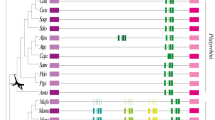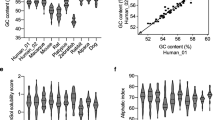Abstract
Immunoglobulin heavy chains are polypeptides encoded by four genes: variable (IGHV), joining (IGHJ), diversity (IGHD), and constant (IGHC) region genes. The number of IGHV genes varies from species to species. To understand the evolution of the IGHV multigene family, we identified and analyzed the IGHV sequences from 16 vertebrate species. The results show that the numbers of functional and nonfunctional IGHV genes among different species are positively correlated. The number of IGHV genes is relatively stable in teleosts, but the intragenomic sequence variation is generally higher in teleosts than in tetrapods. The IGHV genes in tetrapods can be classified into three phylogenetic clans (I, II, and III). The clan III and/or II genes are relatively abundant, whereas clan I genes exist in small numbers or are absent in most species. The genomic organization of clan I, II, and III IGHV genes varies considerably among species, but the entire IGHV locus seems to be conserved in the subtelomeric or near-centromeric region of chromosome. The presence or absence of specific IGHV clan members and the lineage-specific expansion and contraction of IGHV genes indicate that the IGHV locus continues to evolve in a species-specific manner. Our results suggest that the evolution of IGHV multigene family is more complex than previously thought and that several factors may act synergistically for the development of antibody repertoire.






Similar content being viewed by others
References
Aitken R, Gilchrist J, Sinclair MC (1997) A single diversified VH gene family dominates the bovine immunoglobulin repertoire. Biochem Soc Trans 25:326S
Altschul SF, Madden TL, Schaffer AA, Zhang J, Zhang Z, Miller W, Lipman DJ (1997) Gapped BLAST and PSI-BLAST: a new generation of protein database search programs. Nucleic Acids Res 25:3389–3402
Cannon JP, Haire RN, Rast JP, Litman GW (2004) The phylogenetic origins of the antigen-binding receptors and somatic diversification mechanisms. Immunol Rev 200:12–22
Early P, Huang H, Davis M, Calame K, Hood L (1980) An immunoglobulin heavy chain variable region gene is generated from three segments of DNA: VH, D and JH. Cell 19:981–992
Ghaffari SH, Lobb CJ (1999) Structure and genomic organization of a second cluster of immunoglobulin heavy chain gene segments in the channel catfish. J Immunol 162:1519–1529
Gibbs RA, Weinstock GM, Metzker ML, Muzny DM, Sodergren EJ, Scherer S, Scott G, Steffen D, Worley KC, Burch PE, Okwuonu G, Hines S, Lewis L, DeRamo C, Delgado O, Dugan-Rocha S, Miner G, Morgan M, Hawes A, Gill R et al. (2004) Genome sequence of the Brown Norway rat yields insights into mammalian evolution. Nature 428:493–521
Gojobori T, Nei M (1984) Concerted evolution of the immunoglobulin VH gene family. Mol Biol Evol 1:195–212
Hedges SB, Kumar S (2002) Vertebrate genomes compared. Science 297:1283–1285
Hughes AL, Yeager M (1997) Molecular evolution of the vertebrate immune system. Bioessays 19:777–786
Kirkham PM, Mortari F, Newton JA, Schroeder HW, Jr. (1992) Immunoglobulin VH clan and family identity predicts variable domain structure and may influence antigen binding. EMBO J 11:603–609
Klein J, Hořejší V (1997) Immunology. Blackwell Science Ltd, Oxford London Malden
Kodaira M, Kinashi T, Umemura I, Matsuda F, Noma T, Ono Y, Honjo T (1986) Organization and evolution of variable region genes of the human immunoglobulin heavy chain. J Mol Biol 190:529–541
Kofler R, Geley S, Kofler H, Helmberg A (1992) Mouse variable-region gene families: complexity, polymorphism and use in non-autoimmune responses. Immunol Rev 128:5–21
Lefranc MP (2001) Nomenclature of the human immunoglobulin heavy (IGH) genes. Exp Clin Immunogenet 18:100–116
Lefranc MP, Lefranc G (2001) The immunoglobulins fact book. Academic, London
Linardopoulou E, Mefford HC, Nguyen O, Friedman C, van den Engh G, Farwell DG, Coltrera M, Trask BJ (2001) Transcriptional activity of multiple copies of a subtelomerically located olfactory receptor gene that is polymorphic in number and location. Hum Mol Genet 10:2373–2383
Litman GW, Rast JP, Shamblott MJ, Haire RN, Hulst M, Roess W, Litman RT, Hinds-Frey KR, Zilch A, Amemiya CT (1993) Phylogenetic diversification of immunoglobulin genes and the antibody repertoire. Mol Biol Evol 10:60–72
Marchalonis JJ, Schluter SF, Bernstein RM, Shen S, Edmundson AB (1998) Phylogenetic emergence and molecular evolution of the immunoglobulin family. Adv Immunol 70:417–506
Matsuda F, Ishii K, Bourvagnet P, Kuma K, Hayashida H, Miyata T, Honjo T (1998) The complete nucleotide sequence of the human immunoglobulin heavy chain variable region locus. J Exp Med 188:2151–2162
Nei M (2007) The new mutation theory of phenotypic evolution. Proc Natl Acad Sci U S A 104:12235–12242
Nei M, Hughes AL (1992) Balanced polymorphism and evolution by the birth-and-death process in the MHC loci. In: Tsuji K, Aizawa M, Sasazuki T (eds) 11th Histocompatibility Workshop and Conference. Oxford University Press, Oxford
Nei M, Kumar S (2000) Molecular evolution and phylogenetics. Oxford University Press, Oxford
Nei M, Rooney AP (2005) Concerted and birth-and-death evolution of multigene families. Annu Rev Genet 39:121–152
Nei M, Gu X, Sitnikova T (1997) Evolution by the birth-and-death process in multigene families of the vertebrate immune system. Proc Natl Acad Sci U S A 94:7799–7806
Nozawa M, Nei M (2007) Evolutionary dynamics of olfactory receptor genes in Drosophila species. Proc Natl Acad Sci USA 104:7122–7127
Ota T, Nei M (1994) Divergent evolution and evolution by the birth-and-death process in the immunoglobulin VH gene family. Mol Biol Evol 11:469–482
Ota T, Nei M (1995) Evolution of immunoglobulin VH pseudogenes in chickens. Mol Biol Evol 12:94–102
Rens W, O’Brien PC, Yang F, Solanky N, Perelman P, Graphodatsky AS, Ferguson MW, Svartman M, De Leo AA, Graves JA, Ferguson-Smith MA (2001) Karyotype relationships between distantly related marsupials from South America and Australia. Chromosome Res 9:301–308
Reynaud CA, Dahan A, Anquez V, Weill JC (1989) Somatic hyperconversion diversifies the single Vh gene of the chicken with a high incidence in the D region. Cell 59:171–183
Reynaud CA, Mackay CR, Muller RG, Weill JC (1991) Somatic generation of diversity in a mammalian primary lymphoid organ: the sheep ileal Peyer’s patches. Cell 64:995–1005
Reynaud CA, Bertocci B, Dahan A, Weill JC (1994) Formation of the chicken B-cell repertoire: ontogenesis, regulation of Ig gene rearrangement, and diversification by gene conversion. Adv Immunol 57:353–378
Roman T, Andersson E, Bengten E, Hansen J, Kaattari S, Pilstrom L, Charlemagne J, Matsunaga T (1996) Unified nomenclature of Ig VH genes in rainbow trout (Oncorhynchus mykiss): definition of eleven VH families. Immunogenetics 43:325–326
Saitou N, Nei M (1987) The neighbor-joining method: a new method for reconstructing phylogenetic trees. Mol Biol Evol 4:406–425
Schroeder HW, Jr., Hillson JL, Perlmutter RM (1990) Structure and evolution of mammalian VH families. Int Immunol 2:41–50
Sitnikova T, Su C (1998) Coevolution of immunoglobulin heavy- and light-chain variable-region gene families. Mol Biol Evol 15:617–625
Sun J, Butler JE (1996) Molecular characterization of VDJ transcripts from a newborn piglet. Immunology 88:331–339
Takahashi K, Nei M (2000) Efficiencies of fast algorithms of phylogenetic inference under the criteria of maximum parsimony, minimum evolution, and maximum likelihood when a large number of sequences are used. Mol Biol Evol 17:1251–1258
Tamura K, Dudley J, Nei M, Kumar S (2007) MEGA4: Molecular Evolutionary Genetics Analysis (MEGA) Software Version 4.0. Mol Biol Evol 24:1596–1599
Tanaka T, Nei M (1989) Positive Darwinian selection observed at the variable-region genes of immunoglobulins. Mol Biol Evol 6:447–459
Thompson JD, Higgins DG, Gibson TJ (1994) CLUSTAL W: improving the sensitivity of progressive multiple sequence alignment through sequence weighting, position-specific gap penalties and weight matrix choice. Nucleic Acids Res 22:4673–4680
Tonegawa S (1983) Somatic generation of antibody diversity. Nature 302:575–581
Ueda T, Naoi H (1999) BrdU-4Na-EDTA-Giemsa band karyotypes of 3 small freshwater fish, Danio rerio, Oryzias latipes, and hodeus ocellatus. Genome 42:531–535
Wallace BM, Wallace H (2003) Synaptonemal complex karyotype of zebrafish. Heredity 90:136–140
Yamanoue Y, Miya M, Inoue JG, Matsuura K, Nishida M (2006) The mitochondrial genome of spotted green pufferfish Tetraodon nigroviridis (Teleostei: Tetraodontiformes) and divergence time estimation among model organisms in fishes. Genes Genet Syst 81:29–39
Yang F, Waldbieser GC, Lobb CJ (2006) The nucleotide targets of somatic mutation and the role of selection in immunoglobulin heavy chains of a teleost fish. J Immunol 176:1655–1667
Acknowledgments
We thank Nikolas Nikolaidis, Dimitra Chalkia, Zhenguo Lin, and Hiroki Goto for their valuable comments and suggestions. This work was supported by NIH grant GM020293-35 to MN.
Author information
Authors and Affiliations
Corresponding author
Electronic supplementary material
Below is the link to the electronic supplementary material.
Supplemental Figure 1
Flowchart for identification of IGHV genes in the vertebrate genomes (GIF 38.4 kb)
Supplemental Table 1
List of IGHV genes in 16 vertebrate species (DOC 1.86 mb)
Supplemental Table 2
Flanking repeat elements of IGHV genes used for identifying orthologous and paralogous genes between humans and chimpanzees. See footnote for detailed information(DOC 237 kb)
Rights and permissions
About this article
Cite this article
Das, S., Nozawa, M., Klein, J. et al. Evolutionary dynamics of the immunoglobulin heavy chain variable region genes in vertebrates. Immunogenetics 60, 47–55 (2008). https://doi.org/10.1007/s00251-007-0270-2
Received:
Accepted:
Published:
Issue Date:
DOI: https://doi.org/10.1007/s00251-007-0270-2




